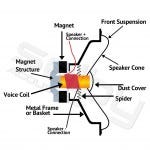Although there are certainly different types of speakers in terms of size, quality and price, essentially the components are pretty similar. These are the basics:
The Enclosure: This is the part that you notice first. The enclosure, also known as “the Box” can be made of various materials including wood or plastic. This houses all the components of your speaker. You decision on which one to buy will often be based on visual elements at this point.
Crossover: This part involves circuits that direct the incoming audio signals toward the drivers. High frequencies are sent to the “tweeter” and low frequencies are sent to the “woofer”. Some speakers also contain a mid-range driver, which as the name suggests, plays the mid-range frequencies.
Drivers: Have the function of creating sound waves. Also known as the “tweeter”, “woofer” & “mid-range”, every speaker uses a different configuration of drivers. Whether a woofer or a tweeter, all drivers comprise of an electromagnetic voice coil, a stationary magnet and a diaphragm. Paper cones are commonly used as diaphragms for woofers, and fabric domes typically used for tweeters. To reproduce the numerous frequencies of sound, high quality speakers typically use different sized cones dedicated to high, medium and low frequencies. The “Voice Coil” is a coil of wire, typically aluminium or copper which the electrical audio signal flows. The voice coil sits in front of the stationary (fixed) magnet and is connected to the cone allowing amplification of the electromagnetic vibrations, releasing sound waves into the air.
Helper components – In order to get the best sound, the following parts are adopted.
Dust Cap: This is a covering which goes over the centre of the cone, obviously reducing the amount of dust that may enter the voicecoil of thedriver, and protecting the integrity and shape of the cone.
Frame: Typically made of steel or aluminium and also referred to as the “basket”, the frame forms a strong structure to mount the driver components.
Spider: Helping centre and keep the voice coil mobile & steady, the spider which has large corrugations and made of a flexible material, serves as a suspension system for the driver. The coil needs to be free to move in and out of the magnet gap, but not side to side.







